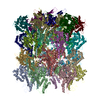[English] 日本語
 Yorodumi
Yorodumi- PDB-8bl4: Cryo-EM structure of a contractile injection system in Streptomyc... -
+ Open data
Open data
- Basic information
Basic information
| Entry | Database: PDB / ID: 8bl4 | ||||||||||||
|---|---|---|---|---|---|---|---|---|---|---|---|---|---|
| Title | Cryo-EM structure of a contractile injection system in Streptomyces coelicolor, the sheath-tube module in extended state. | ||||||||||||
 Components Components |
| ||||||||||||
 Keywords Keywords | STRUCTURAL PROTEIN / Contractile injection system | ||||||||||||
| Function / homology |  Function and homology information Function and homology information | ||||||||||||
| Biological species | Streptomyces coelicolor A3 | ||||||||||||
| Method | ELECTRON MICROSCOPY / helical reconstruction / cryo EM / Resolution: 3.9 Å | ||||||||||||
 Authors Authors | Casu, B. / Sallmen, J.W. / Schlimpert, S. / Pilhofer, M. | ||||||||||||
| Funding support |  Switzerland, European Union, Switzerland, European Union,  United Kingdom, 3items United Kingdom, 3items
| ||||||||||||
 Citation Citation |  Journal: Nat Microbiol / Year: 2023 Journal: Nat Microbiol / Year: 2023Title: Cytoplasmic contractile injection systems mediate cell death in Streptomyces. Authors: Bastien Casu / Joseph W Sallmen / Susan Schlimpert / Martin Pilhofer /   Abstract: Contractile injection systems (CIS) are bacteriophage tail-like structures that mediate bacterial cell-cell interactions. While CIS are highly abundant across diverse bacterial phyla, representative ...Contractile injection systems (CIS) are bacteriophage tail-like structures that mediate bacterial cell-cell interactions. While CIS are highly abundant across diverse bacterial phyla, representative gene clusters in Gram-positive organisms remain poorly studied. Here we characterize a CIS in the Gram-positive multicellular model organism Streptomyces coelicolor and show that, in contrast to most other CIS, S. coelicolor CIS (CIS) mediate cell death in response to stress and impact cellular development. CIS are expressed in the cytoplasm of vegetative hyphae and are not released into the medium. Our cryo-electron microscopy structure enabled the engineering of non-contractile and fluorescently tagged CIS assemblies. Cryo-electron tomography showed that CIS contraction is linked to reduced cellular integrity. Fluorescence light microscopy furthermore revealed that functional CIS mediate cell death upon encountering different types of stress. The absence of functional CIS had an impact on hyphal differentiation and secondary metabolite production. Finally, we identified three putative effector proteins, which when absent, phenocopied other CIS mutants. Our results provide new functional insights into CIS in Gram-positive organisms and a framework for studying novel intracellular roles, including regulated cell death and life-cycle progression in multicellular bacteria. | ||||||||||||
| History |
|
- Structure visualization
Structure visualization
| Structure viewer | Molecule:  Molmil Molmil Jmol/JSmol Jmol/JSmol |
|---|
- Downloads & links
Downloads & links
- Download
Download
| PDBx/mmCIF format |  8bl4.cif.gz 8bl4.cif.gz | 2.1 MB | Display |  PDBx/mmCIF format PDBx/mmCIF format |
|---|---|---|---|---|
| PDB format |  pdb8bl4.ent.gz pdb8bl4.ent.gz | 1.7 MB | Display |  PDB format PDB format |
| PDBx/mmJSON format |  8bl4.json.gz 8bl4.json.gz | Tree view |  PDBx/mmJSON format PDBx/mmJSON format | |
| Others |  Other downloads Other downloads |
-Validation report
| Summary document |  8bl4_validation.pdf.gz 8bl4_validation.pdf.gz | 1.7 MB | Display |  wwPDB validaton report wwPDB validaton report |
|---|---|---|---|---|
| Full document |  8bl4_full_validation.pdf.gz 8bl4_full_validation.pdf.gz | 1.7 MB | Display | |
| Data in XML |  8bl4_validation.xml.gz 8bl4_validation.xml.gz | 285.6 KB | Display | |
| Data in CIF |  8bl4_validation.cif.gz 8bl4_validation.cif.gz | 449.6 KB | Display | |
| Arichive directory |  https://data.pdbj.org/pub/pdb/validation_reports/bl/8bl4 https://data.pdbj.org/pub/pdb/validation_reports/bl/8bl4 ftp://data.pdbj.org/pub/pdb/validation_reports/bl/8bl4 ftp://data.pdbj.org/pub/pdb/validation_reports/bl/8bl4 | HTTPS FTP |
-Related structure data
| Related structure data |  16101MC  8bkyC M: map data used to model this data C: citing same article ( |
|---|---|
| Similar structure data | Similarity search - Function & homology  F&H Search F&H Search |
- Links
Links
- Assembly
Assembly
| Deposited unit | 
|
|---|---|
| 1 |
|
- Components
Components
| #1: Protein | Mass: 57465.113 Da / Num. of mol.: 24 / Mutation: Insertion 26-IEGVG / Source method: isolated from a natural source / Source: (natural)  Streptomyces coelicolor A3(2) (bacteria) / References: UniProt: Q9L0N8 Streptomyces coelicolor A3(2) (bacteria) / References: UniProt: Q9L0N8#2: Protein | Mass: 16493.668 Da / Num. of mol.: 24 / Source method: isolated from a natural source / Source: (natural)  Streptomyces coelicolor A3(2) (bacteria) / References: UniProt: Q9L0N9 Streptomyces coelicolor A3(2) (bacteria) / References: UniProt: Q9L0N9 |
|---|
-Experimental details
-Experiment
| Experiment | Method: ELECTRON MICROSCOPY |
|---|---|
| EM experiment | Aggregation state: PARTICLE / 3D reconstruction method: helical reconstruction |
- Sample preparation
Sample preparation
| Component | Name: The sheath-tube module of a contractile injection system in Streptomyces coelicolor Type: COMPLEX / Entity ID: all / Source: NATURAL |
|---|---|
| Source (natural) | Organism:  Streptomyces coelicolor A3(2) (bacteria) Streptomyces coelicolor A3(2) (bacteria) |
| Buffer solution | pH: 8 |
| Specimen | Embedding applied: NO / Shadowing applied: NO / Staining applied: NO / Vitrification applied: YES |
| Vitrification | Instrument: FEI VITROBOT MARK IV / Cryogen name: ETHANE-PROPANE |
- Electron microscopy imaging
Electron microscopy imaging
| Experimental equipment |  Model: Titan Krios / Image courtesy: FEI Company |
|---|---|
| Microscopy | Model: FEI TITAN KRIOS |
| Electron gun | Electron source:  FIELD EMISSION GUN / Accelerating voltage: 300 kV / Illumination mode: FLOOD BEAM FIELD EMISSION GUN / Accelerating voltage: 300 kV / Illumination mode: FLOOD BEAM |
| Electron lens | Mode: BRIGHT FIELD / Nominal defocus max: 3500 nm / Nominal defocus min: 1500 nm |
| Image recording | Electron dose: 60 e/Å2 / Film or detector model: GATAN K2 SUMMIT (4k x 4k) |
- Processing
Processing
| CTF correction | Type: PHASE FLIPPING AND AMPLITUDE CORRECTION |
|---|---|
| Helical symmerty | Angular rotation/subunit: 23.1 ° / Axial rise/subunit: 38.5 Å / Axial symmetry: C6 |
| 3D reconstruction | Resolution: 3.9 Å / Resolution method: FSC 0.143 CUT-OFF / Num. of particles: 18822 / Symmetry type: HELICAL |
 Movie
Movie Controller
Controller












 PDBj
PDBj